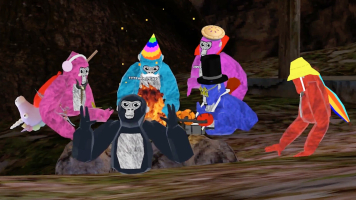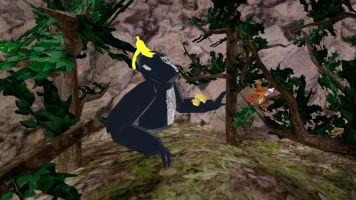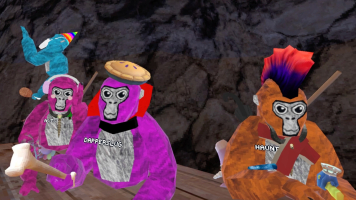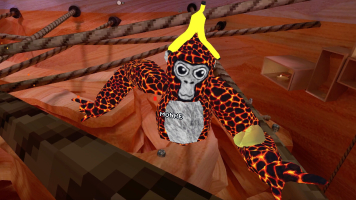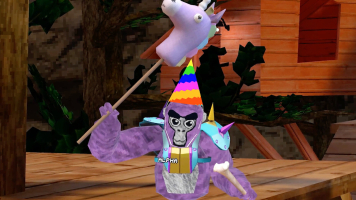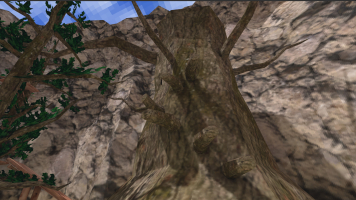Upon first donning my VR headset and launching Gorilla Tag, I was immediately immersed in a world that transcended conventional platformers. The experience evoked the simplicity of childhood imagination combined with the intensity of real-time physical interactions. From the very moment the game loaded, I felt as though I had been transported to an alternative universe where the primal curiosity of exploration and playful instinct reigned supreme. It was a fascinating blend of nostalgia and modern innovation that instantly captured my attention.
Embracing the Power of Vertical Movement
One of the first things that struck me about Gorilla Tag was its inventive approach to movement. Eschewing the standard joystick or trackpad controls, the game relies entirely on the player’s natural arm motions to propel the avatar. I recall spending several minutes in the game's introductory area, learning to swing my arms in a manner that felt both challenging and intuitive when trying to move upward or traverse expansive gaps. This method of movement is not only refreshing but also demands a level of physical engagement that few VR games manage to achieve. Each arc of my reach and every leap felt like an organic extension of my own body, fostering a connection between my physicality and the virtual ape persona I had embraced.
Exhilaration in Multiplayer Madness
My journey took an exciting turn when I joined a session with other players online. Gorilla Tag shines brightest in its multiplayer mode, where every session is a dynamic dance of attention, strategy, and sheer fun. I found myself engaging in high-spirited chases, where the thrill of evasion and pursuit reigned. The unpredictability of human opponents as opposed to programmed NPCs magnified the excitement considerably. I have spent countless hours learning to navigate not only the complex structure of the maps but also interpreting the movements and tactics of fellow players. The spontaneous challenges and cooperative escapes created an adrenaline rush that was both intensely competitive and jovially communal.
Innovative Mechanics That Redefine VR Interaction
Gorilla Tag’s control scheme might seem unorthodox at first glance, but it is precisely this unconventional approach that sets it apart. With no traditional buttons to press, I had to adjust my gameplay to rely solely on physical gestures. The realization that I was regulating my movements through realistic arm swings and hand placements instilled a sense of inventive challenge and immersion. Often, I found myself improvising new ways to combine movements to execute tricky maneuvers, like launching from one tree branch to another or evading a pursuing opponent by swiftly altering my trajectory. This system not only redefines what it means to interact with virtual environments but also invites players to push the boundaries of their motor skills in a playful, unscripted manner.
Aesthetic Minimalism with Expansive Depth
The visual presentation of Gorilla Tag is something I grew to appreciate the most as I delved deeper into the game. Its simplistic design belies the deep intricacies hidden beneath the surface. The graphics embrace a stylized, almost cartoon-like simplicity, focusing on clear, vibrant environments that emphasize movement and spatial awareness over photorealistic details. I was struck by the clever use of color and tonal contrasts that not only enhanced visibility in the three-dimensional space but also contributed to the overall immersive atmosphere. The level of detail in the jungle environments, the rocky outcrops, and even the subtle cues from the sky and light all combined to create a world that was as accessible as it was captivating.
An Auditory Journey Complementing the Visuals
Every time I found myself soaring across a gap or dodging an opponent’s grasp, the audio design played a significant role in intensifying the experience. The ambient sounds within Gorilla Tag are meticulously designed to draw attention to the energy of each environment. Whether it was the rustling of leaves or the distant call of wildlife, every sound was a subtle hint contributing to the overall immersion. I particularly admired how the sound effects synchronized with my movements; the subtle echoes of my arm swings and the dynamic shift in audio based on spatial positioning transformed each session into a sensory-rich adventure. The auditory cues frequently guided me through tight spaces and served as both warnings and reinforcements during intense moments of play.
The Community That Breathes Life Into the Game
Beyond the technical and aesthetic aspects, the social component of Gorilla Tag is where the game truly flourishes. My interactions within the Gorilla Tag community were among the most rewarding aspects of my time in VR. The vibrant community of players is welcoming, creative, and always up for sharing new game strategies or impromptu challenges. I found that playing alongside people who are equally passionate about the game fosters a unique sense of camaraderie. Discussions about innovative movement techniques, shared experiences of impressive feats, and even friendly competitions created an environment that was both inclusive and intellectually stimulating. This communal spirit transformed every session into a festival of collective participation, making every victory or near miss feel all the more significant.
Challenging the Senses Through a Natural Learning Curve
The inherent challenge in Gorilla Tag lies in its demand for physical coordination and timing precision, both of which contribute to its distinctive learning curve. Initially, transitions between casual exploration and competitive sessions can be demanding. I vividly remember the early days when miscalculations in my arm movements often led to unintended tumbles or awkward landings. However, each stumble became a motivator to refine my technique and learn from my mistakes. What really impressed me was that every failure taught something new—whether it was a more efficient method to navigate spatial obstacles or the subtle cues from audio and visual feedback that allowed me to better anticipate the actions of my adversaries. This mastery-over-movement aspect of the game continually honed both my reflexes and my strategic decision-making.
Dynamic Map Environments and Spatial Puzzles
Exploring the intricately designed maps of Gorilla Tag has been a journey filled with discovery and tactical gameplay. The maps are not merely static backdrops but interactive stages where every tree, branch, and rocky formation serves as a tool for movement and strategy. I spent considerable time experimenting with different routes and discovering secret paths that led to advantageous positions. The spatial puzzles embedded within each map challenge a player to exploit the environment, whether by finding a hidden route or by using the natural obstacles as cover during pursuit modes. The strategic depth is evident in how even the smallest detail in the terrain can be leveraged to outwit a determined opponent. Every map felt like a new riddle waiting to be deciphered, a continuous invitation to explore further.
Incorporating Physical Engagement Into Digital Play
The integration of physical activity into the gameplay of Gorilla Tag has had a profound impact on my overall experience. Unlike conventional games where interaction is mediated through minimal bodily movement, Gorilla Tag demands that I engage my entire arm and upper body. This natural physical involvement often results in a workout, though that was never my primary objective when I started playing. Nonetheless, the heartbeat of the game is its ability to seamlessly blend physical exercise with the virtual thrill of exploration and competition. On many occasions, I found that the physical exertion was as satisfying as completing an intricate maneuver within the game. The rhythm of my movements, the sweat from effort, and the exhilaration of a well-executed jump fused to create an experience that is as healthy as it is enjoyable.
Balancing Simplicity and Depth in Game Design
The purist approach to game design in Gorilla Tag is a constant reminder that immersive gameplay does not necessarily require complex graphics or convoluted narratives. Instead, what it offers is a crisp, unfiltered experience where every element of the game is meticulously polished and directly related to the core mechanics. The absence of unnecessary embellishments focuses the player’s attention fully on the interaction between movement, strategy, and environment. I found that this lean approach removes the distractions often present in more elaborately designed games. Instead, it reinforces the elegance of its design philosophy—where every swing, every leap, and every strategic pause is crucial to survival and success in the virtual world.
Uncovering New Strategies with Each Session
What truly captivates me about Gorilla Tag is the endless array of strategies that unfolds with each new session. I have often marveled at how the environment and player behavior dynamically interact to create new challenges every time I log in. Sometimes, I would find myself turning a seemingly ordinary maneuver into a game-changing tactic, capitalizing on unexpected opportunities presented by fellow players’ missteps. This fluidity ensures that no two games are ever identical, and it continually draws me back in, eager to experiment with innovative techniques. Whether I was choosing to climb a precarious formation for a vantage point or timing my movements to intersect perfectly with an opponent’s path, each decision carried weight, making every round a unique exercise in creativity and tactical adaptation.
Moments of Personal Triumph and Discovery
Every time I engaged with Gorilla Tag, there were moments that I consider personal milestones of achievement. I recall instances where my persistent practice paid off as I mastered a particularly challenging maneuver or discovered a hidden pathway that provided a strategic advantage. These moments—though small in the grand tapestry of the game—felt monumental to me. They reinforced the idea that progress in Gorilla Tag is not merely about winning against others but also about personal growth, improvement, and the continuous joy of exploration. Each breakthrough, whether in perfecting a jump or in anticipating the movements of an adversary, transformed the game from a simple pastime into an enriching journey of self-improvement and creative thinking.
Pros

- Unique movement mechanics that engage your entire body during gameplay
- Immersive multiplayer feature that fosters real-time strategic interactions with other players
- Simplistic yet appealing aesthetics that emphasize clear visibility and fluid motion
- Dynamic map designs that encourage creative navigation and tactical planning
- A vibrant community that offers support, shared learning, and friendly competition
- Innovative control scheme that redefines VR interaction in a refreshing way
Cons

- Physical activity requirement can be challenging in limited play spaces
- Learning curve may be steep for players not accustomed to natural gesture-based controls
- Graphical simplicity might not satisfy players who expect detailed, high-fidelity environments








